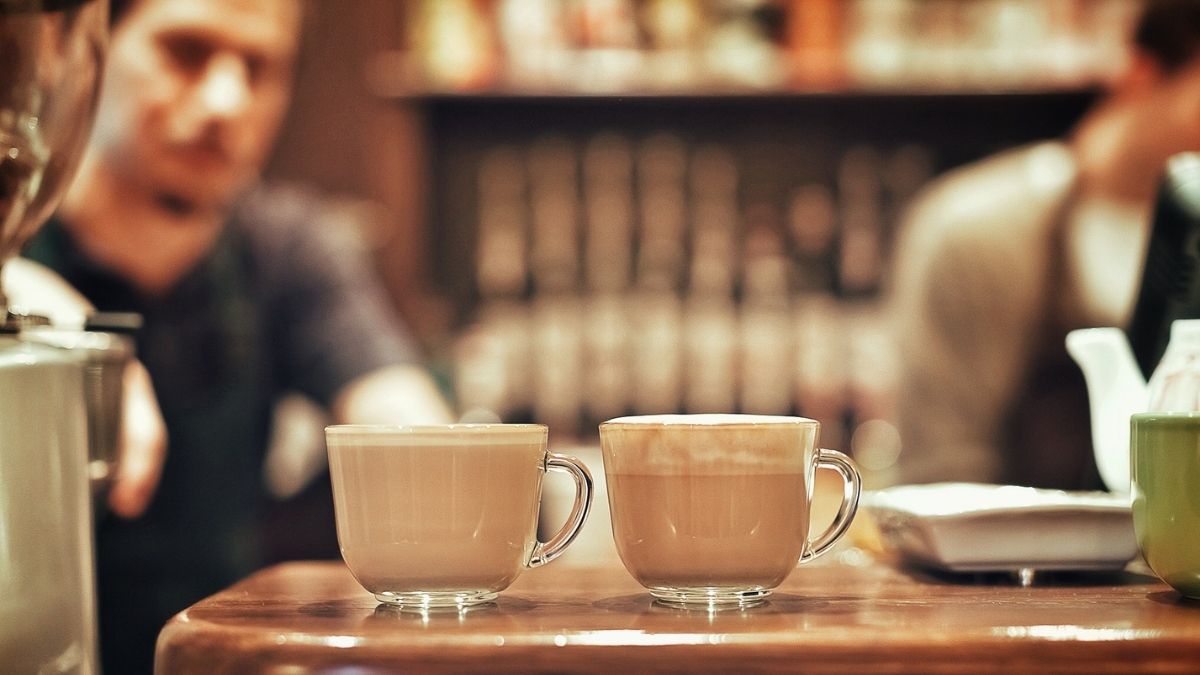Both coffee latte and cappuccino are among the popular Italian drinks that are made from espresso and prepared with hot water. So is it a coffee latte? Or cappuccino for you? Both are great, but what’s the difference?
Cappuccino, in its strictest form, is small with a thick layer of foam and is equally made with espresso, steamed milk, and milk foam. It is traditionally served in a 150 to 180 ml cup with a handle and has a stronger flavor of espresso because of less milk. Coffee Latte, on the other hand, is traditionally larger and contains more steamed milk, and a lighter layer of foam with the espresso and steamed milk blended together.
For coffee lovers out there, it’s time to know the difference between a coffee latte and a cappuccino. And we’re here to clear these things out. Well, at least for the sake of your favorite cup of coffee.
Cappuccino
The name derived from the religious order of the Catholic Church, Capuchin Friars who wore a shade of brown hooded robes. It originated in Austria, but later took its development in Italy where it grew famous in Europe and later around the world.
Traditionally, cappuccino is espresso-based served with steamed milk foam or microfoam. Commercialized versions have emerged through the years with some coffee enthusiasts adding cream instead of milk. Non-dairy alternatives are also being used with cinnamon or chocolate powder flavoring.
As time passed, different makeovers have evolved, including bone dry cappuccino. This is made with espresso and milk foam without steam milk. Other variations are wet cappuccino, dry cappuccino, cappuccino freddo, classical cappuccino, and iced cappuccino.
Cappuccino is often prepared using an espresso machine. It’s where the espresso itself is poured first into the cup followed by the steamed milk. The milk foam is then poured into the top, which can be decorated with drawings called latte art.
In continental Europe, cappuccino is usually served in the morning paired with pastries, at least until 11 A.M. This is because cappuccino is packed with milk and is considered too heavy to consume later in the day.
Coffee Latte
Often called “latte,” this classic coffee drink was named after the Italian term caffellatte, meaning coffee and milk. It’s made with a single or double shot of espresso and steamed milk and is traditionally served hot although cold variation has also evolved.
Coffee latte variants have also become popular, including chocolate-flavored mocha. Others would replace coffee with another base such as mate, matcha, turmeric, rooibos, and masala chai or spiced Indian tea. Other vegan or lactose-intolerant coffee lovers would use non-dairy milk such as soy or almond milk instead of the traditional creamy milk.
Coffee latte is traditionally part of European cuisine and is commonly part of breakfast. In Italy, it’s brewed with a stovetop called moka pot, and poured into a cup filled with heated or steamed milk. The milk in the original Italian coffee latte is not foamed with adding sugar as optional depending on the drinker.
However, outside of Italy, a coffee latte is served with a thin layer of foamed milk, usually prepared in a 240 ml cup or glass, which is larger than a cup of cappuccino. In the U.S., a coffee latte is more sweetened with 3% more sugar, which is already called latte macchiato in Italy.
- Iced latte. While a coffee latte is traditionally served hot, different versions have evolved, including an iced latte. Unliked hot latte, it’s usually made with chilled milk poured over ice with sugar or other flavoring syrups such as hazelnut or vanilla. Sometimes, an iced latte is also served with blended ice or even frozen in advance so the drink won’t warm up.
Is Coffee Latte Or A Cappuccino Healthier?
Both cappuccino and coffee latte contains similar amounts of caffeine from a single or double shot of espresso per serving. However, they differ in sugar and milk content as a cappuccino gets a lesser amount of milk while a coffee latte gets more heated or steamed milk.
Coffee latte has the most amount of milk and added sweeteners, which means that it has higher calories, fat, and protein. As for a cappuccino, it contains less milk, but still gets a good amount of protein, calories, and fat per serving.
For those who are keeping count of their calories and fat intake, a cappuccino gives you better figures than a coffee latte, especially when you’re lactose-intolerant. For vegans, both drinks are still accessible for you as you can use almond or soy milk instead of the traditional cow’s milk. Both almond and soy milk have the ability to create a foamy texture like cow’s milk.
Is A Cappuccino Or A Coffee Latte More Expensive?
The answer is both are expensive. Most coffees that you get from Starbucks, Panera Bread, Pret-a-Manger, Peet’s, or Caribou Coffee are priced as much as you get a serving of salad. For instance, for a cup of vanilla soy coffee latte at Starbucks, you’ll pay between $6 and $7. No stylish crafted on top of that foamy milk. No special ingredients.
The price of coffee from the farmers has been stable in the last 30 years. There have been times that coffee beans would jack up to $3 a pound, but would relatively go below a dollar a few days or a week later. What makes your coffee latte and cappuccino or any other coffee drink expensive are the utilities, ingredients, employee wages, rent, taxes, business insurance, among others.
But most farmers who plant and harvest the coffee cherries still live below the poverty line while coffee drinks are pricey in the market. This is due to how coffees are processed and sold. Farmers would sell their harvest to processors. These processors would then sell them to exporters.
These exporters work with different clients in the market such as brokers, roasters, and other traders. Each of them has different mark-up prices for every pound of bean. The moment your favorite coffee reaches your table, it becomes more expensive than you imagined.
How Does Milk Foam?
Frothing or foaming in milk is caused by protein, particularly the whey proteins present in milk. The proteins create a film or spheres around the air bubble surfaces in the foam. While heating the milk, water vapor and air are forced into it causing a microfoam
This is created using a frother for a cappuccino, and a steam wand of an espresso machine for a coffee latte. Foamed milk is as healthy as the milk itself. Despite the fact that frothing changes the milk’s texture, it doesn’t affect its nutrition value.
Microfoam is used to create a wet cappuccino, while macrofoam is used to make a dry cappuccino. A wet cappuccino is usually less foamy with more steamed milk. As for a dry cappuccino, it’s foamier with less steamed milk.
Do You Call A Cappuccino Without Foam A Coffee Latte?
By any chance, a cappuccino and a coffee latte both have foamed milk. A coffee latte though has less foamed milk, while a cappuccino gets more. However, in general, you can order a cappuccino with less foam, but it’s more appropriate to say a “coffee latte without foam.” Baristas will certainly make it for you.
Is Regular Drip Coffee Stronger Than A Cappuccino And A Coffee Latte?
The answer is yes. While both cappuccino and coffee latte contains a single or double shot of espresso, a regular coffee has more caffeine content, ounce for ounce.
If you want more caffeine in your coffee, ask for one that’s made with a light roast. Dark roast coffee has less caffeine than lighter ones.
Is A Coffee Latte Better Than A Cappuccino?
Your preference is the answer. There’s no better coffee drink than the other. So it really depends on what you like or need. Coffee drinks have different amounts of caffeine as well as sweeteners used to make them.
However, if you have sweet tooth, a coffee latte is ideal for you as it contains more steamed milk than a cappuccino. On the other hand, if you are into coffees with foamed milk, a cappuccino would be best for you.
There are many types of coffee drinks that have been popular through the years. Others have evolved commercially with more flavoring syrups or sweeteners. Macchiato, americano, black, red eye, doppio, flat white, cortado, ristretto, galão, lungo, mocha, affogato, café au lait, and Irish are among the famous coffee drinks worldwide.
The Bottom Line
Regardless of your favorite cup of coffee, it’s still important to know how good or bad it is for you, especially when you’re a regular coffee drinker. Both cappuccino and coffee latte offer different nutritional values when it comes to calories, protein, and fat. It only depends on what you need for the day.
Just don’t forget that drinking coffee in moderation is key to a healthier lifestyle. So don’t be afraid to get a cup of coffee daily. Just don’t consume more than the recommended daily intake which is up to 400 mg of caffeine content.

